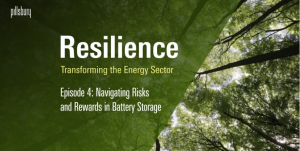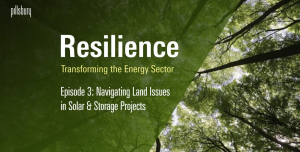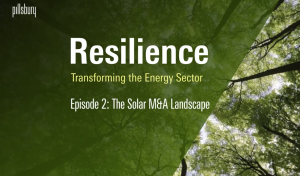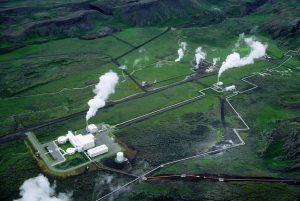 Last week, on one of his final days in office, President Biden signed an executive order aimed at boosting the development of energy facilities and data centers for artificial intelligence (AI) technology. Executive Order 14141 directs the secretaries of Defense, Energy and the Interior to lease sites on federal land to private sector companies for the purpose of building data centers and energy generation and transmission facilities. Noting that AI technology has become, and is expected to remain, a “defining technology of our era,” and that both economic and national security risks could arise if the United States falls behind in the race to build AI infrastructure, the Order seeks to reduce regulatory barriers to these projects by speeding the permitting process, and ambitiously seeks to enable construction at these federal sites to commence by January 1, 2026.
Last week, on one of his final days in office, President Biden signed an executive order aimed at boosting the development of energy facilities and data centers for artificial intelligence (AI) technology. Executive Order 14141 directs the secretaries of Defense, Energy and the Interior to lease sites on federal land to private sector companies for the purpose of building data centers and energy generation and transmission facilities. Noting that AI technology has become, and is expected to remain, a “defining technology of our era,” and that both economic and national security risks could arise if the United States falls behind in the race to build AI infrastructure, the Order seeks to reduce regulatory barriers to these projects by speeding the permitting process, and ambitiously seeks to enable construction at these federal sites to commence by January 1, 2026.
Articles Posted in Energy
Resilience: Transforming the Energy Sector – Navigating Risks and Rewards in Battery Storage | Episode 4 (12.18.24)
 In the newest episode of Resilience, Pillsbury’s Shellka Arora-Cox and guest Adam Hise, Managing Director of Storage Risk Solutions for Ascend Analytics, dive deep into the evolving world of battery storage, market volatility, and how companies are navigating risk in a dynamic energy landscape.
In the newest episode of Resilience, Pillsbury’s Shellka Arora-Cox and guest Adam Hise, Managing Director of Storage Risk Solutions for Ascend Analytics, dive deep into the evolving world of battery storage, market volatility, and how companies are navigating risk in a dynamic energy landscape.
Trump 2.0: Electric Vehicles (EVs) and Emissions Requirements
In a potential blow to the fledging EV transition, reports have noted that the Trump transition team is planning to terminate the $7,500 consumer EV credit, an action publicly supported by Elon Musk.
Resilience: Transforming the Energy Sector – Navigating Land Issues in Solar and Storage Projects | Episode 3 (11.14.24)
 In the latest episode of the Resilience podcast, colleague Shellka Arora-Cox and Laura Pagliarulo, CEO and founder of SolaREIT, get down to the nitty-gritty in a discussion of the interplay of solar power capacity, generation and land use.
In the latest episode of the Resilience podcast, colleague Shellka Arora-Cox and Laura Pagliarulo, CEO and founder of SolaREIT, get down to the nitty-gritty in a discussion of the interplay of solar power capacity, generation and land use.
Developers Can Tap into DOE’s $400 Million for Remote and Rural Clean Energy Projects
 On October 3, 2024, the Department of Energy Office of Clean Energy Demonstrations announced a Notice of Funding Opportunity (NOFO) to fund up to $400 million for clean energy projects in rural and remote areas via its Energy Improvements in Rural or Remote Areas program. The NOFO will provide awards ranging from $2 million – $50 million, with plans to fund 20 to 50 projects. Awards will require a non-federal cost share, range across four topic areas, and target projects in rural and remote communities with populations of 10,000 people or fewer.
On October 3, 2024, the Department of Energy Office of Clean Energy Demonstrations announced a Notice of Funding Opportunity (NOFO) to fund up to $400 million for clean energy projects in rural and remote areas via its Energy Improvements in Rural or Remote Areas program. The NOFO will provide awards ranging from $2 million – $50 million, with plans to fund 20 to 50 projects. Awards will require a non-federal cost share, range across four topic areas, and target projects in rural and remote communities with populations of 10,000 people or fewer.
Resilience: Transforming the Energy Sector – The Solar M&A Landscape | Episode 2 (10.23.24)
 In the latest episode of the Resilience podcast, colleague and host Shellka Arora-Cox sits down with Kevin Yaich, head of M&A at Qcells USA, for a discussion of the current solar M&A landscape.
In the latest episode of the Resilience podcast, colleague and host Shellka Arora-Cox sits down with Kevin Yaich, head of M&A at Qcells USA, for a discussion of the current solar M&A landscape.
Big Data Meets Big Green: Data Centers and Carbon Removal Compete for Zero-Emission Energy
 Artificial intelligence, data centers, carbon removal and zero-emission power may sound like a winning line (plus the Free Space) on a 2024 Buzzword Bingo card. But the concepts have come into dramatic real-world tension as private and public actors seek to accommodate the digital and environmental imperatives for green energy.
Artificial intelligence, data centers, carbon removal and zero-emission power may sound like a winning line (plus the Free Space) on a 2024 Buzzword Bingo card. But the concepts have come into dramatic real-world tension as private and public actors seek to accommodate the digital and environmental imperatives for green energy.
After years of fairly stable demand, punctuated by declines during the pandemic and economic slumps, electricity demand is projected to double by 2050. A principal cause is the rapid expansion in the power needed to energize and cool servers amid explosive growth in the number and size of data centers, crypto miners, and other point sources of computation. Data centers were 3% of U.S. demand and are projected to be up to 9% or more by 2030; AI will drive a 160% surge in data center demand by 2030. A commentator notes, “We haven’t seen [growth like] this in a generation.” Continue Reading ›
Developer Perspectives on Today’s Energy Storage Markets
In 2023, the world added an impressive 45 gigawatts/97 gigawatt-hours of energy storage capacity, nearly tripling year-on-year growth, with the majority driven by battery storage installations. The global energy storage market is projected to continue its rapid expansion in 2024, adding over 100 gigawatt-hours of capacity, primarily from the United States and China. In the United States, battery storage capacity on the grid has grown tenfold to 16,000 megawatts, with expectations to double again this year, led by significant growth in Texas, California and Arizona.
A distinguished panel of energy storage developers convened at the 2024 Infocast Energy Storage Finance & Investment Summit in San Diego to discuss the current market dynamics and future trajectory of energy storage. The following is an edited transcript of their discussion.
Enhanced Geothermal Energy Could Be the Next Zero-Carbon Hero
 Hydrogen, solar, wind—and even microwave beams from outer space—are a few of the alternative energies being explored as the world strives to cut the cord on carbon emissions. Recently, advancements in geothermal energy technologies appear poised to significantly expand geothermal’s reach. These new methods, varyingly referred to as enhanced, engineered or advanced geothermal systems (collectively referred to here as EGS), have recently made strides in scalability and grabbed the attention of changemakers. If successful, EGS may play a major role in the clean energy transition. The technique creates no emissions and is virtually limitless (it pulls from heat generated by the Earth’s core), and can provide constant baseload power, making it appealing to green-minded investors. This article calls attention to the progress and variety of EGS projects and proposals that Pillsbury sees as part of the ongoing energy transition.
Hydrogen, solar, wind—and even microwave beams from outer space—are a few of the alternative energies being explored as the world strives to cut the cord on carbon emissions. Recently, advancements in geothermal energy technologies appear poised to significantly expand geothermal’s reach. These new methods, varyingly referred to as enhanced, engineered or advanced geothermal systems (collectively referred to here as EGS), have recently made strides in scalability and grabbed the attention of changemakers. If successful, EGS may play a major role in the clean energy transition. The technique creates no emissions and is virtually limitless (it pulls from heat generated by the Earth’s core), and can provide constant baseload power, making it appealing to green-minded investors. This article calls attention to the progress and variety of EGS projects and proposals that Pillsbury sees as part of the ongoing energy transition.
Environmental Justice Update: The Justice40 Initiative
Soon after taking office, President Biden issued Executive Order 14008, entitled, “Tackling the Climate Crisis at Home and Abroad.” This is an unusually long and complex executive order and includes many provisions relating to environmental justice and the plight of “disadvantaged communities” that are overwhelmed by many environmental threats. Section 223 of the Order describes the President’s “Justice40 Initiative,” which is designed to ensure that 40% of Federal benefits flow to disadvantaged communities through an “all of government approach.” There is a recognition that some disadvantaged communities lack the personnel and resources to take advantage of this Initiative, so technical training funds will be made available. The Order establishes new offices throughout the Federal bureaucracy to handle and expedite environmental justice matters.
 Gravel2Gavel Construction & Real Estate Law Blog
Gravel2Gavel Construction & Real Estate Law Blog


